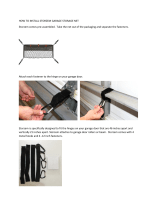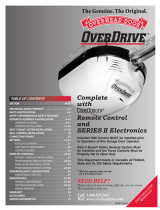
OVERVIEW OF
POTENTIAL HAZARDS
Garage doors are large, heavy objects that move with the help of springs
under high tension and electric motors. Since moving objects, springs under
tension, and electric motors can cause injuries, your safety and the safety of
others depend on you reading the information in this manual, if you have
questions or do not understand the information presented, call your nearest
service representative.
in this section and those that foilow, the words Danger, Warning, and
Caution are used to emphasize important safety information.
The word:
,_ DANGER means that severe injury or death wilt result from failure
to follow instructions.
,_ WARNING means that severe injury or death can result from failure
to follow instructions.
,_ CAUTION means that property damage or injury can result from
failure to foliow instruction.
The word f40*__:is used to indicate important steps to be followed
or important considerations.
FILL THISIN ATTIMEOF INSTALLATIONFORYOUROWN
RECORDS,SOTHATITWILL
BE AVAILABLE IFYOU EVERNEEDTOCALL US.
Date Purchased / /
Serial Number / / (See Fig. 1-1)
Operator Model
DealerName
DealerAddress
City
State
Zip
S'_ou d se vFo@eve" be ,u,_dr_,d
IMPORTANT
INSTALLATION
INSTRUCTIONS
,
,
Toreducethe risk of
severeinjuryordeath:
READ AND FOLLOW ALL SAFETY,
INSTALLATION AND OPERATION
INSTRUCTIONS. If you have any questions
or do not understand an instruction, call your
service representative.
Do Not install Opener on an improperly
balanced door. An improperly balanced
door may cause severe injury. Repairs and
adjustments to cables, spring assemblies,
and other hardware must be made by a
trained service person using proper tools
and instructions.
3. Remove all handles and ropes, and
disable all locks connected to the door
before installing the Opener.
4. Install door Opener 7' or more above
the floor. Mount the emergency release
knob 6' above the floor.
5. Do Not connect the Opener to the
power source until instructed to do so.
6. Locate theWall Control:
* Within sight of the garage door.
* At a minimum height of 5', so small
children cannot reach it.
* Away from all moving parts of the
garage door.
7. Install the entrapment WARNING label
next to the wall button or console. Install
the emergency release tag on the
emergency release.
8. The operator must reverse when the door
contacts a 11/2" high object on the floor at
the center of the doorway. This is the size of
a 2" x 4" board laid flat.
Visit our website at:
www.geniecompany.com
SAVETHESEINSTRUCTIONS

























